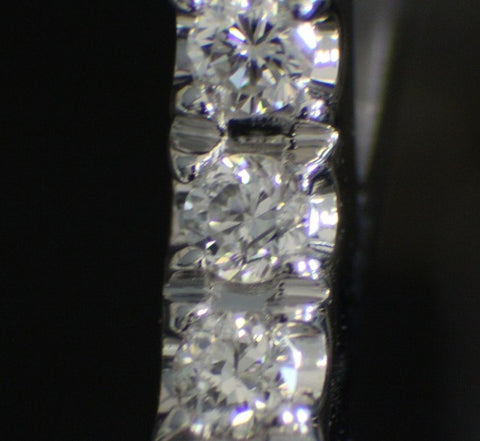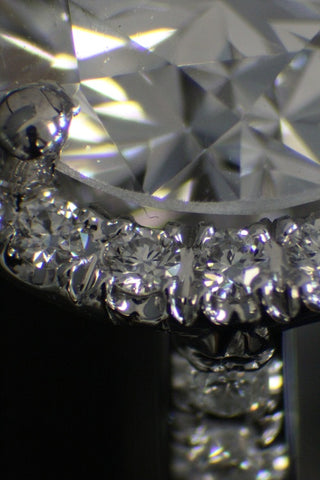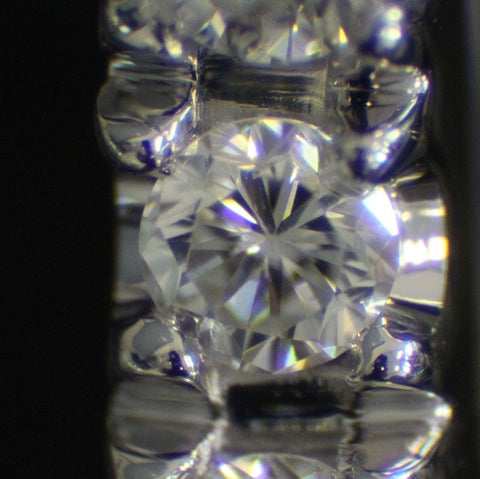Micro Pave Diamond Halo Rings - What makes this styling so popular.
Lets talk about Micro Pave diamond halo rings!
Micro Paves popularity for the past several years has been on the rise, and appears to be more than just a fad. Despite lower prices due to lower quality made pieces from overseas, micro pave is still in demand.
Ideally all consumers would have a perfect knowledge of this and have an easy time separating cheap, poorly crafted imports from high-end quality work. There has to be a premium for high quality pieces.
By cutting corners on important steps in the setting process most companies are able to produce micro pave rings that somewhat mimic a well made version to the untrained eye. But it should be known these pieces never measure up to close scrutiny or daily wear and tear. Some common signs of poorly made micro pave are: roughness to the touch; unevenness of texture and clarity; misshapen beads; and too much metal covering the stones.
The term "micro pavé” is in reference to a method of setting tiny diamonds or colored stones (also known as melee) onto the surface of a jewelry piece with a precision that is only possible using high magnification. Below is an example of a micro set halo ring we just completed recently. Later on there will be close ups so you can see the setting work.

There are many other synonyms of the term, including : mini pave, micro set
microscopic pave.
A common mistake is to use the term Pave or Micro Pave as the same thing. They are very different and should not be used interchangeably
The main difference between micro pave and pave is that the diamonds or stones used in micro pave are smaller and are set using a different method. Most experts will say the ring must be entirely set by hand including the bead or U setting. This is how we do our micro pave settings, a lot of other companies will use the cheaper alternative of having the Cad design actually have the tiny beads in the design so when you print the wax the prongs will be on there. This is a cheaper way of doing it but does not come near the quality of hand setting and making the beads by hand in the metal.As you can see in the close up photos below, each bed is perfectly made to hold the diamonds in place. This is also a U setting as you can see the "U" like design from the side view. We are mostly using G Color VS Clarity diamonds so even in these close up pictures you will not see inclusions in our diamonds.




Pave setting on the other hand is very different, it is more of a low tech style of setting in which a diamond setter will drill or form holes to an area of jewelry and then place diamonds that fit into the holes. From there you use another tool to form beads of metal that hold the diamond in place. This form of setting goes back a very long time.
Pave and micro pave come in different setting styles.
1, Royal Pave - Has a common bead to hold three stones in a honeycomb pattern. Each bead has to be large enough in order to cover all three stones. Six beads hold each stone in place.
2. Four Bead Pave - In a four bead setting there are four beads solely dedicated to each stone and the beads are smaller.
We typically use four bead pave as we find it more aesthetically pleasing and fewer stones fall out. It also allows for the diamonds to be shown without too much metal covering.
Some ways for identifying micro pave are:
Stones are calibrated
Stone sizes are typically less than 1.4mm
There are no walls or separations between the rows of stones.
Stones are set densely together with very small beads arranged in perfect rows.
Symmetry: Micro pave involves a symmetry of all aspects involved
1. The beads of metal holding each stone
2. Fine detail that gives stones the appearance of hovering above the surface
3. There are arches in the sides of the rows; equal spacing and positioning of the stones with their tables leveled; and, of course, each stone's cut and proportions.
The sizes of stones used in micro pave settings are usually measured in fractions of millimeters - the measurement representing the diameter of a stone, not its carat size. Most commonly used sizes for micro pave range from 0.70 mm to 1.3 mm.
Setting Capabilities:
It is very important to have a master setter, he must have a good microscope as it is necessary to make good work. We use GIA microscopes, these tend to be the best from our experience. Head worn visors do not work well enough. Without a proper microscope bad results will most likely occur, such as clumps of metal bead and random stones buried between cuts.
Cad Cam:
Some jewelers will use cad cam to make multiple tiny little prongs perfectly formed in the prototype or wax. (Remember, in the classic definition of pave setting, the holes for the diamonds are drilled into the actual metal and the little beads or prongs are formed by hand) This method enables the ring to made significantly cheaper however the quality is also far lower.
At Ben-Dannie Inc. we use CAD CAM to make a custom project but not use the technology to form the tiny prongs or beads to hold the stones. What we do is have a very highly skilled diamond setter tearfully layout the tiny diamonds that will fit into the design and then carefully set by hand each of the tiny diamonds by drilling into the metal and then hand forming beads (prongs) etc.
Overall micro pave rings, necklaces, bracelets, pendants, ect... are all very popular in today world. How long the trend will continue remains to be unseen but for the foreseeable future it seems as though it is here to stay.